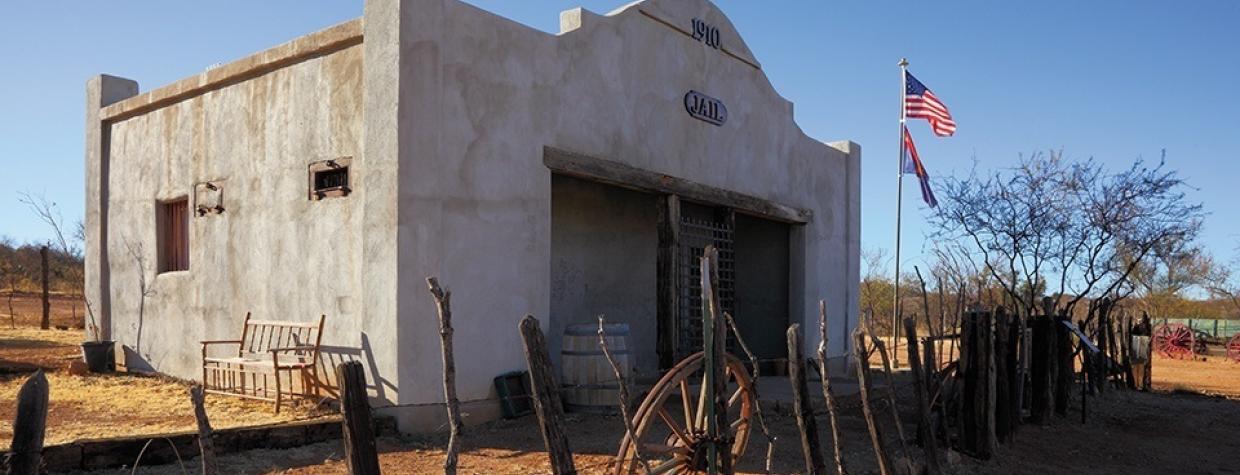Tombstone to Pearce
History can be fickle. Long after the last gunfighter was planted on Boot Hill, Tombstone survived to grow into an international tourist attraction. Yet neighboring towns with pasts nearly as colorful have faded into oblivion, leaving behind faint scars on the landscape.
Just outside Tombstone, a lonely dirt road weaves through desert scrub, in the shadow of the rugged Dragoon Mountains, and links three former mining communities. Gleeson, Courtland and Pearce are strung along the length of the aptly named Ghost Town Trail, a drive blending scenery and history in one outing.
Follow the signs to Gleeson from Tombstone and you soon exchange boardwalk streets for a sprawling sky and cloud shadows wafting across rolling hills. Just before reaching Gleeson, take a quick detour to the most unusual gift boutique in Arizona. Makeshift signs for Rattlesnake Crafts lead down a side road to where an old trailer is surrounded by an astounding collection. Antiques, artifacts, rusted tools, old guns, bottles and minerals are displayed in open-air “rooms,” piled atop weathered shelves or mounted on fences. The trailer is packed with handcrafted items like wallets, belts, knife sheaths and cellphone cases made from rattlesnake leather. If you want to make a purchase and no one is around, drop the cash in the wooden mailbox.
Next stop is Gleeson, once home to the Chiricahua Apache tribe that mined turquoise for jewelry and trade. After the tribe’s members were either killed off or relocated, prospectors continued mining turquoise, but when a man named John Gleeson discovered a large copper deposit, the town boomed.
During its heyday, Gleeson reached a population of more than 1,000. Today, about five people live in or near the town limits. Although few, they’re an energetic bunch. A couple of residents have purchased and completed restoration of the 1910 Gleeson Jail. It’s now open the first and fourth Saturdays of each month, and other times by appointment. Inside, you’ll find artifacts, memorabilia and a map for a walking tour where you can see the cemetery and remnants of the schoolhouse and hospital. The Bono Store and Saloon also still stands. Peek inside to see a mural painted in 1982 that depicts the townsfolk.
A mile past Gleeson, turn left onto Ghost Town Trail Road and continue to Courtland, a fleeting boomtown. Starting in the early 1900s, big companies sank shaft after shaft at a fever pitch, encouraged by high-grade copper findings. The population swelled to 2,000, and the town boasted a newspaper, movie theater, ice-cream parlor and auto dealership, among its many businesses. Then the ore pinched out and the mines closed around 1920. During the ensuing decades, the desert reclaimed the town, leaving only scattered foundations and crumbling ruins, including the unrestored twin of the Gleeson jail.
Nearby Pearce replaced Tombstone as the local Wild West town. When gold was discovered in 1896, many families and businesses relocated from Tombstone, where the mines had flooded. The Alvord-Stiles Gang, responsible for numerous robberies and shootings, operated out of Pearce. The town prospered into the 1930s before emptying. Yet sitting on U.S. Route 191, Pearce survives. Several historic buildings are intact, and a couple of shops are open for business.
Note: Mileages are approximate.
Length: 34 miles one way
Directions: From Tombstone, drive east on State Route 80 to Camino San Rafael. Turn left onto Camino San Rafael, drive 1 mile, and turn right onto Gleeson Road. Continue for about 14 miles. Turn left at Ghost Town Trail/Gleeson-Pearce Road.
Vehicle Requirements: None
Warning: Back-road travel can be hazardous, so be aware of weather and road conditions. Carry plenty of water. Don’t travel alone, and let someone know where you are going and when you plan to return.
Information: Gleeson Jail, 520-508-1802 or www.gleesonarizona.com

